Theft is every biker’s worst nightmare and tragically, is still a huge problem, especially in big cities. As such, it is now essential to invest in extra security devices to help protect your pride and joy. With so many choices, this motorcycle security guide will go through the pros and cons of different security measures so you can opt for the most effective ways to prevent motorcycle theft and avoid wasting money.
Of course, we all have insurance cover, but many of us will have high excesses to keep premiums affordable. If your bike is stolen, there is a chance it will be recovered, but this can leave you even worse off as there may be recovery and storage bills from the Police and a hefty repair bill. Never mind the hike in premiums for several years to come. For a cheap commuter bike, theft cover is almost pointless as it would just be too uneconomical to claim.
Bike recovery figures have improved drastically over the last few years. The NCIS (National Crime Intelligence Service) report from 2001 quoted a figure of just 16% of stolen bikes being recovered. A decade on and the figure is looking better at around about 45% across the EU. This is almost certainly due to advancements in GPS tracking technologies and smart identification systems.
Around 80% of motorbike theft occurs at home (as surveyed by the NCIS), so it makes sense to install the strongest security measures there, consider an extra beefy chain, CCTV or a locked garage. Then use a lighter weight and more portable security can be carried for use away from home.
Motorcycle Security Guide
Over the following sections, you can read about:
- Common attacks employed by thieves
- What do different Security Certifications mean
- Debate on many security devices to avoid motorcycle theft
- Conclusion on best overall practices
Common Attacks
First, let’s look at some of the common attacks thieves employ to give you an idea of what tactics we’re up against.
Freeze Spray: A can of freeze spray can make many metals extremely brittle so they can easily be shattered with a lump hammer. Watch this video to see just how easy this attack is. Freeze attacks are effective again D-Locks and chains too.
Bolt Croppers: 42″ croppers have tough jaws and long handles capable of providing a lot of pressure and will easily break most chains with links less than 15mm in diameter. Check out this video from Almax showing how easily lesser chains can be bolt cropped:
Lock Picking: this attack takes considerable skill and is more common for very cheap locks, models with known flaws or by professionals after a very high-value bike. That said, see how quickly this well regarded Squire SS65C padlock gets picked in the video below:
Power Tools: Small battery-powered tools are becoming more common these days, with a mini angle grinder able to break almost any chain or disc lock in a relatively short space of time.
Skate Board: Placed under the front wheel, it will allow a pair to push an immobilised bike away to somewhere quieter and less risky to buy time to attack devices further and hot-wire the bike.
Scooter Piggyback: If a bike can’t be quickly hot-wired, it can easily be pushed away by an accomplice on a scooter. Once taken somewhere quiet, they’ll be able to take time to remove any GPS tracker and get it started.
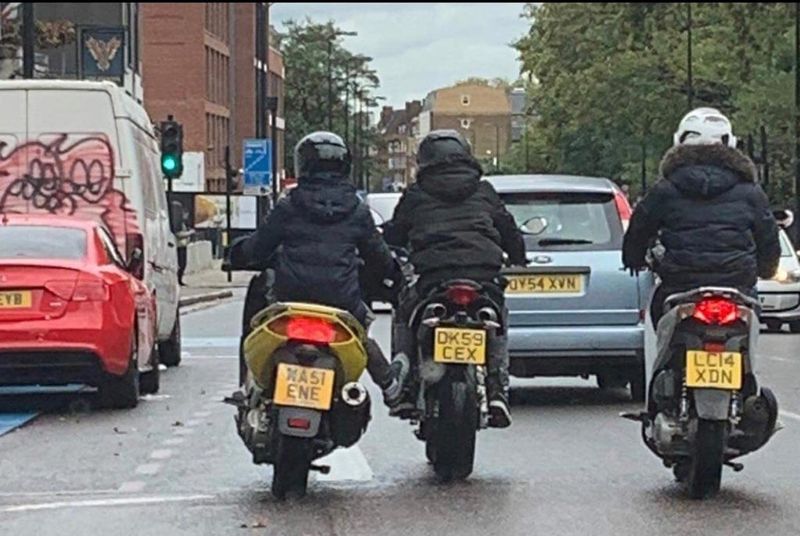 Van: Anything not chained down can be lifted into a van in seconds by a couple of strong guys. Once loaded, alarms will be muffled and attackers can then tackle any security devices at their leisure.
Van: Anything not chained down can be lifted into a van in seconds by a couple of strong guys. Once loaded, alarms will be muffled and attackers can then tackle any security devices at their leisure.
House Entry for Keys: Common for all automotive theft, it is often easier for thieves to break into a house and steal keys so they can unlock, disarm and drive away a vehicle.
Immobiliser / Ignition Bypass Kits: Easily available online, thieves can purchase special circuits, wiring looms and other plugin gadgetry to bypass immobilisers, alarms, key transponders etc. These allow a thief to quickly hotwire and start a stolen bike regardless of what modern electronic security it may have.
Security Certifications
There’s a whole host of certifications you might find adorned on security devices that supposedly pertain to how good they are at avoiding motorcycle theft, but what do they really mean?
For Padlocks, the standard is the newish EU-wide CEN EN12320 standard (which is pretty much the same as British Standard BS EN 12320), which goes from 1 (worst) to 6 (best).
For everything else, the best certification to look for is the Sold Secure standard. Sold Secure rates all kinds of security devices and gives items a Bronze, Silver or Gold rating. But do bear in mind, because they rate all kinds of stuff: bicycles, ATVs/quads, caravans, etc, ratings are not comparable between categories. A motorcycle gold rating is not the same as a bicycle gold rating. Ultimately, even a Gold rating isn’t that high and has been awarded to basic 14mm chains that can be cropped in seconds (e.g. Oxford Monster).
Steering Lock
The first line of defence that almost all recent bikes will have is a steering lock. It’s simple and quick to use but unfortunately, it doesn’t afford much protection, a good kick of the bars will often break it. Check out this video to see how easy it is to break, not pleasant viewing.
Some may argue it’s not worth using as it will just incur more costly repairs, however, that’s only true if you still have the bike. If it can delay a thief by 10 seconds, adding risk which combined with other obstacles, it might overall put them off. It also increases the odds they’ll be disturbed and have to leg it.
Rain Covers
 So what theft protection does a rain cover afford? Well, not a huge amount to be honest, however, it does have some key advantages. It will hide your bike from sight, so a passing thief will not know if it’s a heap of crappy commuter hack or a super posh Ducati. It will also slow a thief down by a few seconds as they remove it, especially if it’s locked on at each wheel (even with just a cheap bicycle lock) and also necessitate bringing a wider range of tools.
So what theft protection does a rain cover afford? Well, not a huge amount to be honest, however, it does have some key advantages. It will hide your bike from sight, so a passing thief will not know if it’s a heap of crappy commuter hack or a super posh Ducati. It will also slow a thief down by a few seconds as they remove it, especially if it’s locked on at each wheel (even with just a cheap bicycle lock) and also necessitate bringing a wider range of tools.
Check out our review of the Oxford Aquatex rain cover.
Secondly, if you find the cover removed, you will know someone’s clocked your bike and it gives you a heads up that you might need to beef up your security.
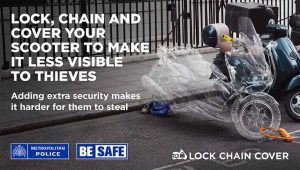 The Met Police recently promoted the use of rain covers in their “Be Safe Lock Chain Cover” campaign to raise awareness of motorbike and scooter theft. Though granted, big dirty, wet, rain covers aren’t the most convenient of items to cart around with you to work…
The Met Police recently promoted the use of rain covers in their “Be Safe Lock Chain Cover” campaign to raise awareness of motorbike and scooter theft. Though granted, big dirty, wet, rain covers aren’t the most convenient of items to cart around with you to work…
Buy the Oxford Aquatex Bike Cover from SportsBikeShop
Immobilisers and Alarms
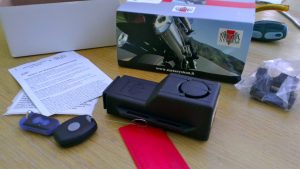
You may have had one of these fitted as standard when you bought your bike, be it an OEM system like Honda’s HISS or a dealer-fitted 3rd party unit. If not, there are many professional companies that can fit one, although not cheap, expect to pay at least £250. The installation involves tapping into the existing wiring loom and/or ECU in an obfuscated fashion to prevent any quick disabling. Most alarms/immobilisers fall into a Thatcham category. These categories go from 1 to 7 but are not a range of effectiveness, rather just different types. If you have a very high-value bike, consider getting a Thatcham CAT5 system fitted. These will automatically report back to a control centre when the bike is stolen and allow them to prevent the bike from being restarted at a distance.
A loud alarm is good for alerting an attack, hopefully, so someone might disturb them so they give up. Just don’t rely on this, there’s no guarantee anyone will pay any attention to an alarm, let alone risk approaching a gang of bike thieves to save a random motorbike.
A professionally fitted device (with a certificate) can also give you a discount on your insurance premium, often around 10%. If you have an OEM immobiliser, don’t assume it will be Thatcham approved, not all manufacturers submit theirs for testing, KTM and Ducati for example. This can become an issue if an insurance policy mandates a Thatcham approved immobiliser.
An immobiliser can be effective at preventing your bike from being hot-wired by a petty thief, but won’t stop it from being pushed away or loaded into a van to transport your bike to a lock-up where the alarm and immobiliser can be removed at leisure.
The final disadvantages of alarms are they will drain your battery over a couple of weeks. Factor in a trickle charger if you don’t ride regularly. Secondly, they can die with age (for example the internal non-replaceable battery on my Meta alarm has a 10-year life span) and have been known to leave riders immobilised. Additionally, there are many easily available kits online that can bypass an immobiliser.
D-Locks
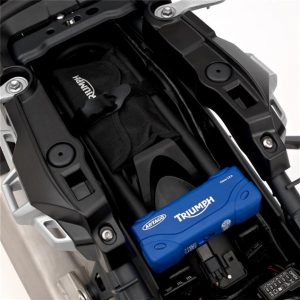
The classic solid metal D-shaped lock used to be commonly sold by bike manufacturers as a handy lock they’ve designed to clip onto the bike or under the seat. Convenience sells. In use, it’s threaded through a wheel and prevents the bike from being ridden away. However, it can easily be broken by either a scissor/bottle jack inside pushing it apart, with the freeze spray method or by inserting a pole and twisting it. As such, ensure there’s little free space inside the D when in use. Since it is difficult to use a D-Lock to lock your bike to a physical object, a skateboard under the wheel or van will soon have your bike away.
Buy the Oxford Alarm-D Lock from SportsBikeShop
Also, avoid any D-Locks with a round style key, many of these (notable by Kryptonite) are incredibly easy to unlock with a Biro pen!
Disc Locks and Lever Locks
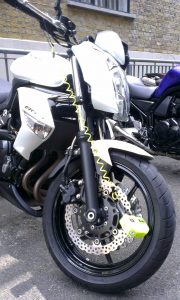
These are popular as they are small enough to stow away under the seat or in a pocket and are not quickly removed. They often also come with loud alarms too. However, many bikers have made the schoolboy error of trying to pull away having forgotten to remove the lock, travelled a couple of feet, and then dropped the bike – Doh!
Many bikers have made the school boy error of trying to pull away having forgotten to remove the lock, travelled a couple of feet and then dropped the bike – Doh!
As such, pick up a bright-coloured bungee that attaches to the handles bars or buy a disc lock with a built-in alarm (for example the Abus Granit 8077 we reviewed) to act as a good reminder it’s in place.
Attack-wise, your bike isn’t tied down, so the skateboard or van attack will soon have your bike somewhere quieter where thieves can take more time to remove the lock. Where possible, attach your disc lock to the rear wheel (unlike the photo above), as it will be harder and more time-consuming for a thief to remove than on the front wheel. Those carrying a battery-powered angle grinder have also been known to cut a segment out of your brake disc to free the lock too…
Also, the alarms on many can be easily and effectively muffled by merely covering them with your hand, they will also need regular battery replacements and not all models hold up well in all weathers.
Search for Disk Locks at SportsBikeShop
Lever Lock
Essentially a clamp that tightly pulls your brake lever to the throttle, preventing your bike from being moved or throttle twisted. Effectiveness and convenience is very similar to a Disc Lock, but it also shares many of the same disadvantages.
Security Chains and Padlocks
A good security chain is par for the course, however, not all chains are made equal. In addition, some consideration on how you chain up your bike is just as important.
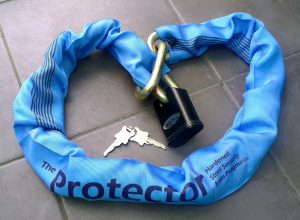
To thwart bolt croppers you need at least 16mm chain links or fatter, these will be too big to even fit in the jaws. Only consider a 14mm chain as a lightweight option purely for low-value bikes. One exception is the very portable LiteLok (reviewed here), which is cleverly designed to withstand bolt croppers and is only susceptible to obscure cable-cutting tools. You should avoid ‘Through-Hardened’ chains, they are just too brittle, once one side of a link has been cut the rest will just shatter. Instead opt for ‘Case-Hardened’ chains, which are very hard on the outside but ductile on the inside, thus requiring both sides of a link to be cropped. Few sub 16mm chains will be case hardened due to the cost and difficulty of applying this process to smaller chains.
Don’t be tempted to throw your chain over your shoulder, it’ll do serious damage to you if you come off your bike.
Case-hardened 16mm and 19mm chains will require power tools to break, which are heavy, possibly noisy and will only be used by determined thieves. The downsides of such hefty chains are weight, a 2m long 16mm chain with padlock weigh in at about 10Kg and as such will really need a top box to carry it about. Don’t be tempted to throw your chain over your shoulder, it’ll do serious damage to you if you come off your bike. Recently chains up to 22mm have hit the market, seriously hardcore! An option to consider for locking a high-value motorbike at home, if it will fit through your wheel…
Recommended chains are the Almax Immobiliser III 16mm chain and the Pragmasis Protector 16 and 19mm chains. Both of these are often sold with the Squire SS65CS padlock, which is CEN6 rated. Either offer one of the best ways to prevent motorcycle theft.
Check out our review of the Pragmasis Protector chain.
It is advisable to try and keep your chain off the ground when locking up, as this can help prevent a hammer attack. With nothing to smash it against, it will be difficult to break. Opting for a shorter chain that’s just long enough with no slack will help here. Although, a longer chain can be more useful when away from home when struggling to find something to chain to.
Chose carefully where on your bike you thread your chain, though the wheels are an obvious choice, they can be removed fairly quickly, especially the front. With a van handy, a bike with one wheel is still worth the effort of pinching. See if you can thread the chain through the frame, behind the downpipes or even over the seat. Otherwise, look at the Pragmasis Anti-Pinch Pin, a solid bar that can be threaded through your bike’s frame or hollow axle and then chained to at each end.
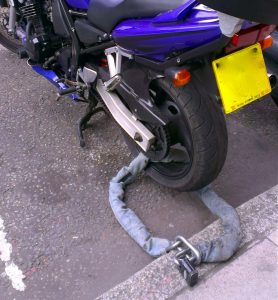
A chain will only ever be as effective as what you chain your bike to. Simply threading it through a wheel and leaving it on the floor will be no more effective than a Disc Lock and leave you wide open to a skateboard or van attack. Similarly, if you wrap your chain around some flimsy railings that can be cut with bolt croppers or freeze-attacked, you’re still no better off. At home install a Ground Anchor (see below) to thread your chain through. When away from home try to find some thick railings, fence/signpost or similar. It’s good to see some solo motorcycle bays in London now have ground anchors and dedicated rails to chain to.
If you can’t find anything to chain to, thread your chain through the chain of a neighbouring bike parked up.
If you really can’t find anything to chain your bike to, thread your chain through the chain of a neighbouring bike parked up. Until the other rider leaves, the two bikes chained together will be very difficult to carry away. The Lock2Lock scheme is actively promoting this tactic and has stickers to put on your bike to encourage it.
One popular way to negate having to carry around a heavy chain is to leave a second chain at work. Besides doubling your outlay, the big problem here is a dedicated thief who has spotted your bike may tamper with your work chain at night so that he can have an easy time stealing your bike in the morning. They may weaken or partly cut the chain underneath the sleeve or even just fill your padlock with Superglue preventing you from even chaining up your bike! I’ve heard of a London biker who keeps a Superglue solvent under his seat after witnessing this.
Ground Anchors
Ground anchors are essentially something solid to thread your security chain through making it impossible to carry away your bike. Highly recommended for securing your bike at home. They generally come in two flavours, a metal ring that is bolted to the ground (or wall) or a U-shaped tube that is sunken into the concrete and is flush with the floor.
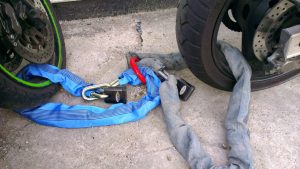
The bolted variety is good if you already have concrete down or only have a solid wall to bolt to. They generally use RawlBolts that expand when tightened or resin to bond bolts solid with concrete, and in both cases, ball bearings are hammered into the bolt heads to prevent them from being undone afterwards. The disadvantage of this type is they could still potentially be attacked with power tools.
Check out our review of the Pragmasis Torc ground anchor.
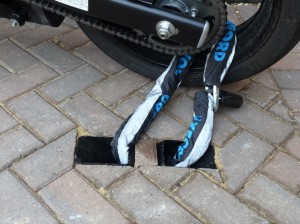
The sunken variety obviously requires more installation work, i.e. a big hole and pile of fresh concrete, but has the advantage of being flush with the ground so can be ridden over easily and are near impossible to attack.
Whatever ground anchor you buy, do double-check it will accommodate the chain (or chains) you wish to thread through it and triple-check positioning before installing…
Vehicle Tracking Devices
Trackers are concealed locating devices carefully installed on the bike. They may use GPS & mobile networks or VHF to transmit their location back to either the owner or the tracker company. GPS-based trackers offer a very high level of accuracy with regard to positioning but can be blocked easily by a metal van or thick-walled garage. VHF-based trackers can send signals through thick walls, are very hard to jam and most police units carry VHF detectors, but can’t be located with such fine-grained accuracy as GPS devices.
Police like trackers as they can lead them to a lock up with many stolen bikes and the guilty parties – suspects and evidence served up on plate for a nice easy case.
One school of thought suggests advertising you have a tracker installed with a nice big sticker and hope this will be a visible deterrent to prevent theft. However, another school of thought suggests keeping it concealed, so a thief is not aware they need to find and remove the tracker as soon as they can. Either way, the main intention of the tracker is so the bike can be recovered. The Police like trackers as they often lead them to a lock-up with many stolen bikes and the guilty parties – suspects and evidence served up on a plate, for a nice easy case.
As with everything, there are a number of key disadvantages:- GPS/GSM-based devices can easily be blocked with a GPS/mobile jamming device or by merely putting the bike in a metal van or garage. Or worse, the GPS could be spoofed so a false location is broadcast back… Such as this GPS attack trialled against a Yacht using just $1000 of kit in a briefcase. VHF doesn’t really provide enough accuracy to narrow down a location in a dense city setting.
The cost can also put many people off, with many professional services starting at around £300 upfront for installation and yearly subscription starting at £100. However, as an alternative, a number of cheap Chinese GPS/GPRS devices can be picked up that you just put a PAYG SIM card in and wire up to the bike battery yourself, for example, the TK102. These can Text your bike’s location when it moves outside a configured boundary or you phone it. No subscription, just top up the SIM card as required. A good installation guide can be found here for such devices. For the super cheapskates, you could just purchase some fake ‘tracker installed’ stickers to slap on your bike…
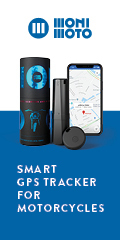 The final disadvantage is if you do get your bike back, what state will it be in? Dropped, trashed, stripped down? You will still likely have an insurance claim for repairs or it’ll be written off, and ultimately you’d perhaps be no better off than had it been gone forever and you just got a payout.
The final disadvantage is if you do get your bike back, what state will it be in? Dropped, trashed, stripped down? You will still likely have an insurance claim for repairs or it’ll be written off, and ultimately you’d perhaps be no better off than had it been gone forever and you just got a payout.
- DataTool Stealth (as was TrakKING) offer a subscription-based GPS/GSM tracker
- Tracker offers a subscription-based GPS/GSM & VHF tracker
- Bike Trac off a subscription-based GPS/GSM & VHF combination tracker
- Monimoto offer a self-contained GPS/GSM tracker with no wiring needed on installation
- Cheap TK102 SIM-based GPS tracker from eBay
With trackers being so popular these days, many stolen bikes are often left in a concealed location, whereupon the thieves wait a day or two to see if it’s recovered via a tracker. So, whether you have a tracker or not, if your bike is stolen do immediately search the local vicinity, you might well find it.
Forensic Markings
There are a number of methods and schemes for applying security markings to key parts of your bike so that they can be traced following a theft. These won’t help prevent theft but will aid the recovery process. With many stolen bikes rapidly getting stripped down and sold for parts, forensic marking help pinpoint all the parts of your bike and improves the odds that you’ll get more of your bike recovered and provide hard evidence for the Police to prosecute.
- Datatag identification system.
- Carole Nash DNA+ forensic marking system.
- Alpha.Dot marking system
CCTV and Floodlights

A great deterrent against theft at home is installing CCTV and PIR sensor floodlights. The former can provide evidence to the police and may put off any opportunist thief. Floodlights serve two purposes, they will ensure your CCTV records good quality footage and will also make a thief more conspicuous, such that you, your neighbours or passers-by can see the attacker.
CCTV is very cheap these days, with a reasonable camera and hard-drive-based recording computer available for around £150-200 in electrical retailers. Even cheaper deals can be found on eBay or Amazon. Many of these devices can be monitored through a phone app too.
A good 20-30W LED floodlight will provide ample illumination and will be far more economical than a traditional 150-200W floodlight. Expect to pay around £30-40 at your local hardware store, possibly less online e.g. this 30W SMD LED one on Amazon.
Garage
A decent locked garage will put off all but the most serious of professional thieves. An extra barrier to break will cost a thief extra time, incurring further risk. Keeping your bikes garaged will likely earn you a nice insurance discount, compared to parking on the street or a driveway. In high-risk areas, a garage may be the only way to get insurance. However, on the flip side, once in your garage a thief can work unnoticed on other security measures you have.
ensure your garage doesn’t contain handy tools a thief could use to steal your bike
However, do still keep your bikes locked up within the garage, ideally with a ground anchor on the floor or wall of the garage. Also, ensure your garage doesn’t contain handy tools a thief could use to steal your bike either and similarly make sure the keys to your bike aren’t accessible to someone in the garage!
A locked shed can also be fairly effective too, but note many insurers won’t accept a wooden shed as sufficient to earn a discount. So be wary if you’ve stipulated your wooden shed as a ‘locked garage’ on your policy, you don’t want to find out it’s void when you put in a claim. Some insurers can also get fussy if your garage is not at your registered address, so double-check all the fine details if you’re renting a garage away from home.
Conclusion: How to avoid motorcycle theft
 Ultimately, there is no single best way to prevent motorcycle theft, no security device will 100% prevent your bike from being stolen. With enough time, resources and skills, all of the devices listed here can be thwarted. The key is, to use a combination of tactics and devices from this motorcycle security guide to make your bike very difficult to steal. If the time, effort and risk involved in overcoming all your security outweigh the value of your bike, you can reduce the likelihood of theft greatly. But note, ‘value’ to a thief maybe sale value on the black market outside of Europe, the value in parts on eBay, a valuable getaway vehicle for later crime, or just fun value for kids on some local scrubland.
Ultimately, there is no single best way to prevent motorcycle theft, no security device will 100% prevent your bike from being stolen. With enough time, resources and skills, all of the devices listed here can be thwarted. The key is, to use a combination of tactics and devices from this motorcycle security guide to make your bike very difficult to steal. If the time, effort and risk involved in overcoming all your security outweigh the value of your bike, you can reduce the likelihood of theft greatly. But note, ‘value’ to a thief maybe sale value on the black market outside of Europe, the value in parts on eBay, a valuable getaway vehicle for later crime, or just fun value for kids on some local scrubland.
As a final strategy, just park your bike next to a more desirable bike with less security than yourself!
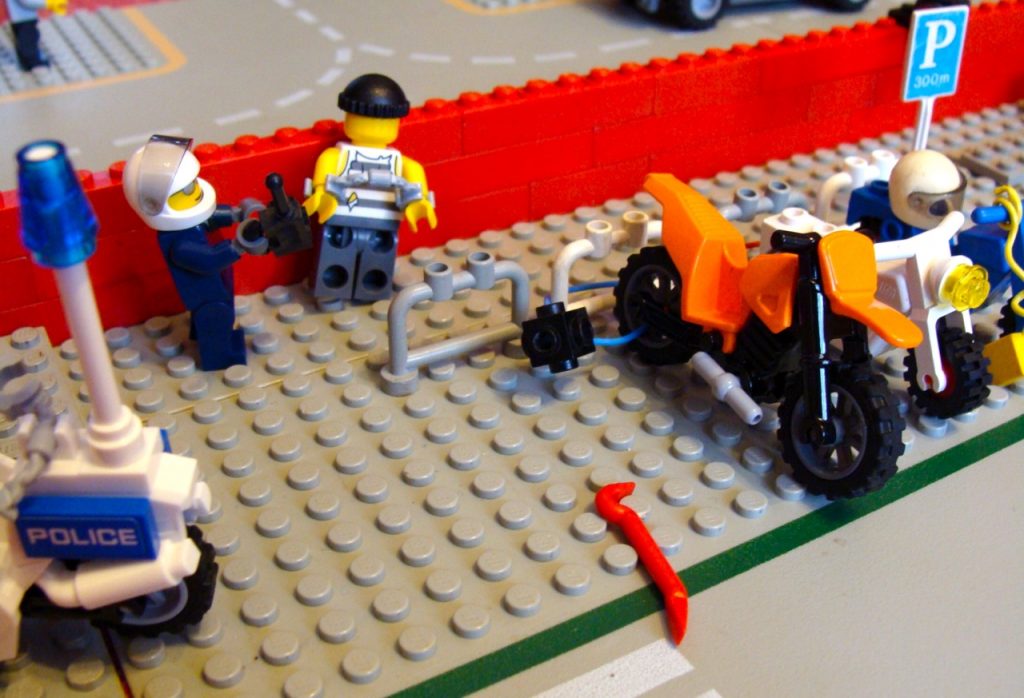
I hope you found this motorcycle security guide helpful. Please do share it among your biker friends and comment below if you’ve come across any other great tactics to beat criminals.
References
- http://www.telegraph.co.uk/motoring/motorbikes/9072284/Where-do-all-the-stolen-motorcycles-go.html
- http://news.bbc.co.uk/1/hi/uk/1642265.stm
- http://www.asgardsss.co.uk/motorcycle-theft-statistics
- http://news.bbc.co.uk/1/hi/uk/1642750.stm
- http://www.motorcyclenews.com/mcn/news/newsresults/archive/83313/83436/83494/83498/
- http://www.mag-uk.org/en/newsdetail?aid=7019
- http://www.motorcyclenews.com/mcn/insurance/advice/security-theft/motorcycle-theft-dont-become-a-statistic/
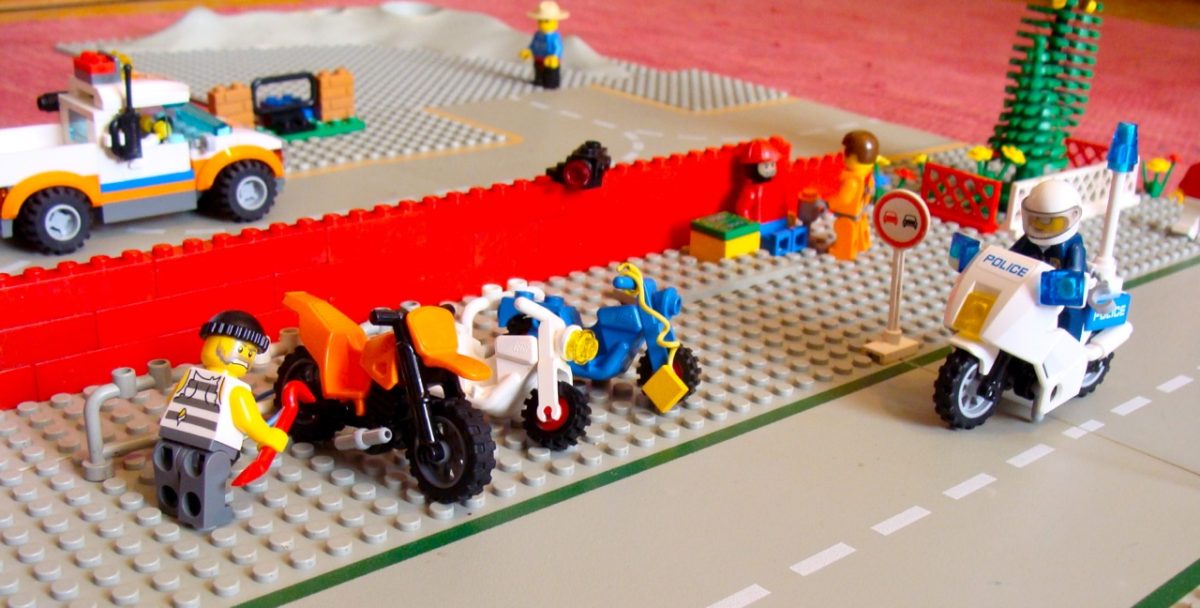





One reply on “Motorcycle Security Guide & Best Ways to Prevent Theft”
I never knew that about 80% of motorcycle theft is at home. I recently bought a motorcycle and I want to make sure I keep it safe. Thank you for the tips, I’ll keep them in mind.